
shell_gpt
A command-line productivity tool powered by AI large language models like GPT-4, will help you accomplish your tasks faster and more efficiently.
Stars: 9019
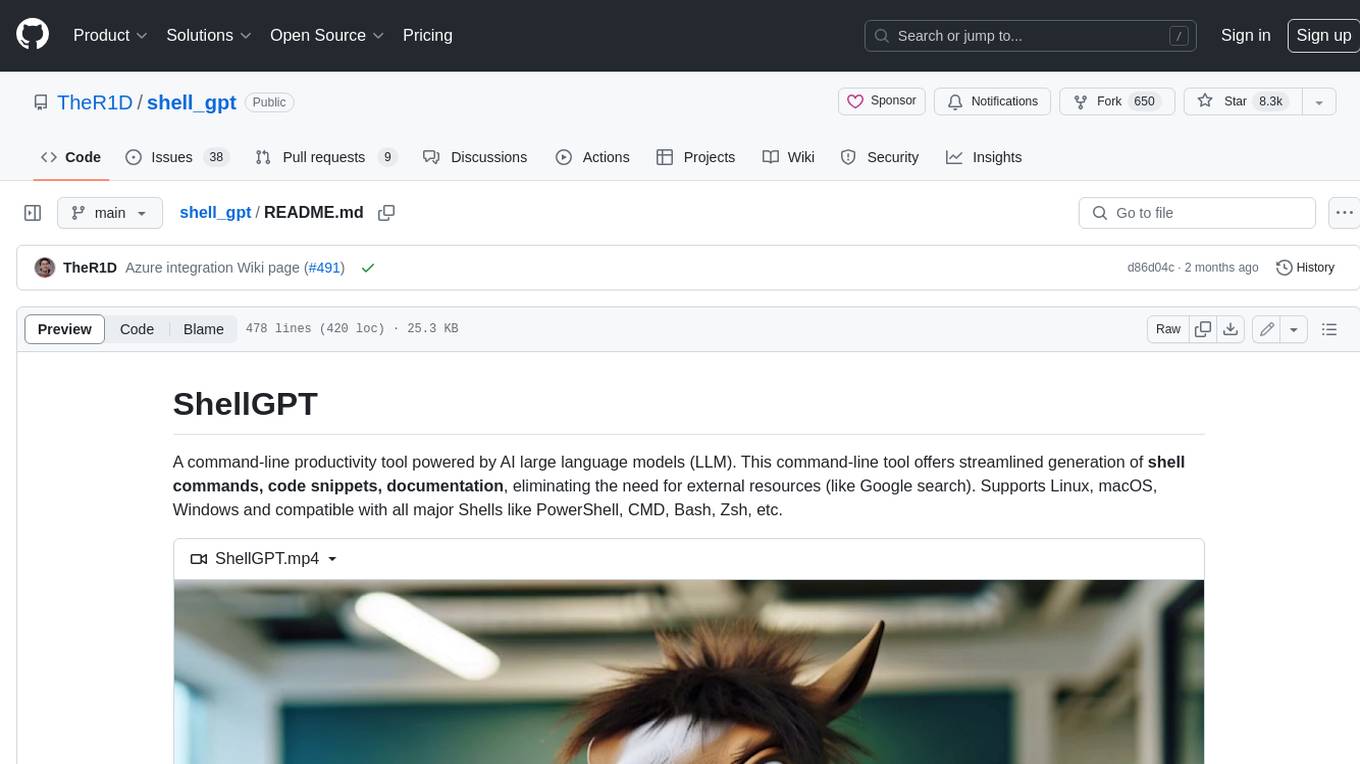
ShellGPT is a command-line productivity tool powered by AI large language models (LLMs). This command-line tool offers streamlined generation of shell commands, code snippets, documentation, eliminating the need for external resources (like Google search). Supports Linux, macOS, Windows and compatible with all major Shells like PowerShell, CMD, Bash, Zsh, etc.
README:
A command-line productivity tool powered by AI large language models (LLM). This command-line tool offers streamlined generation of shell commands, code snippets, documentation, eliminating the need for external resources (like Google search). Supports Linux, macOS, Windows and compatible with all major Shells like PowerShell, CMD, Bash, Zsh, etc.
https://github.com/TheR1D/shell_gpt/assets/16740832/9197283c-db6a-4b46-bfea-3eb776dd9093
pip install shell-gptBy default, ShellGPT uses OpenAI's API and GPT-4 model. You'll need an API key, you can generate one here. You will be prompted for your key which will then be stored in ~/.config/shell_gpt/.sgptrc. OpenAI API is not free of charge, please refer to the OpenAI pricing for more information.
[!TIP] Alternatively, you can use locally hosted open source models which are available for free. To use local models, you will need to run your own LLM backend server such as Ollama. To set up ShellGPT with Ollama, please follow this comprehensive guide.
❗️Note that ShellGPT is not optimized for local models and may not work as expected.
ShellGPT is designed to quickly analyse and retrieve information. It's useful for straightforward requests ranging from technical configurations to general knowledge.
sgpt "What is the fibonacci sequence"
# -> The Fibonacci sequence is a series of numbers where each number ...ShellGPT accepts prompt from both stdin and command line argument. Whether you prefer piping input through the terminal or specifying it directly as arguments, sgpt got you covered. For example, you can easily generate a git commit message based on a diff:
git diff | sgpt "Generate git commit message, for my changes"
# -> Added main feature details into README.mdYou can analyze logs from various sources by passing them using stdin, along with a prompt. For instance, we can use it to quickly analyze logs, identify errors and get suggestions for possible solutions:
docker logs -n 20 my_app | sgpt "check logs, find errors, provide possible solutions"Error Detected: Connection timeout at line 7.
Possible Solution: Check network connectivity and firewall settings.
Error Detected: Memory allocation failed at line 12.
Possible Solution: Consider increasing memory allocation or optimizing application memory usage.
You can also use all kind of redirection operators to pass input:
sgpt "summarise" < document.txt
# -> The document discusses the impact...
sgpt << EOF
What is the best way to lear Golang?
Provide simple hello world example.
EOF
# -> The best way to learn Golang...
sgpt <<< "What is the best way to learn shell redirects?"
# -> The best way to learn shell redirects is through...Have you ever found yourself forgetting common shell commands, such as find, and needing to look up the syntax online? With --shell or shortcut -s option, you can quickly generate and execute the commands you need right in the terminal.
sgpt --shell "find all json files in current folder"
# -> find . -type f -name "*.json"
# -> [E]xecute, [D]escribe, [A]bort: eShell GPT is aware of OS and $SHELL you are using, it will provide shell command for specific system you have. For instance, if you ask sgpt to update your system, it will return a command based on your OS. Here's an example using macOS:
sgpt -s "update my system"
# -> sudo softwareupdate -i -a
# -> [E]xecute, [D]escribe, [A]bort: eThe same prompt, when used on Ubuntu, will generate a different suggestion:
sgpt -s "update my system"
# -> sudo apt update && sudo apt upgrade -y
# -> [E]xecute, [D]escribe, [A]bort: eLet's try it with Docker:
sgpt -s "start nginx container, mount ./index.html"
# -> docker run -d -p 80:80 -v $(pwd)/index.html:/usr/share/nginx/html/index.html nginx
# -> [E]xecute, [D]escribe, [A]bort: eWe can still use pipes to pass input to sgpt and generate shell commands:
sgpt -s "POST localhost with" < data.json
# -> curl -X POST -H "Content-Type: application/json" -d '{"a": 1, "b": 2}' http://localhost
# -> [E]xecute, [D]escribe, [A]bort: eApplying additional shell magic in our prompt, in this example passing file names to ffmpeg:
ls
# -> 1.mp4 2.mp4 3.mp4
sgpt -s "ffmpeg combine $(ls -m) into one video file without audio."
# -> ffmpeg -i 1.mp4 -i 2.mp4 -i 3.mp4 -filter_complex "[0:v] [1:v] [2:v] concat=n=3:v=1 [v]" -map "[v]" out.mp4
# -> [E]xecute, [D]escribe, [A]bort: eIf you would like to pass generated shell command using pipe, you can use --no-interaction option. This will disable interactive mode and will print generated command to stdout. In this example we are using pbcopy to copy generated command to clipboard:
sgpt -s "find all json files in current folder" --no-interaction | pbcopyThis is a very handy feature, which allows you to use sgpt shell completions directly in your terminal, without the need to type sgpt with prompt and arguments. Shell integration enables the use of ShellGPT with hotkeys in your terminal, supported by both Bash and ZSH shells. This feature puts sgpt completions directly into terminal buffer (input line), allowing for immediate editing of suggested commands.
https://github.com/TheR1D/shell_gpt/assets/16740832/bead0dab-0dd9-436d-88b7-6abfb2c556c1
To install shell integration, run sgpt --install-integration and restart your terminal to apply changes. This will add few lines to your .bashrc or .zshrc file. After that, you can use Ctrl+l (by default) to invoke ShellGPT. When you press Ctrl+l it will replace you current input line (buffer) with suggested command. You can then edit it and just press Enter to execute.
By using the --code or -c parameter, you can specifically request pure code output, for instance:
sgpt --code "solve fizz buzz problem using python"for i in range(1, 101):
if i % 3 == 0 and i % 5 == 0:
print("FizzBuzz")
elif i % 3 == 0:
print("Fizz")
elif i % 5 == 0:
print("Buzz")
else:
print(i)Since it is valid python code, we can redirect the output to a file:
sgpt --code "solve classic fizz buzz problem using Python" > fizz_buzz.py
python fizz_buzz.py
# 1
# 2
# Fizz
# 4
# Buzz
# ...We can also use pipes to pass input:
cat fizz_buzz.py | sgpt --code "Generate comments for each line of my code"# Loop through numbers 1 to 100
for i in range(1, 101):
# Check if number is divisible by both 3 and 5
if i % 3 == 0 and i % 5 == 0:
# Print "FizzBuzz" if number is divisible by both 3 and 5
print("FizzBuzz")
# Check if number is divisible by 3
elif i % 3 == 0:
# Print "Fizz" if number is divisible by 3
print("Fizz")
# Check if number is divisible by 5
elif i % 5 == 0:
# Print "Buzz" if number is divisible by 5
print("Buzz")
# If number is not divisible by 3 or 5, print the number itself
else:
print(i)Often it is important to preserve and recall a conversation. sgpt creates conversational dialogue with each LLM completion requested. The dialogue can develop one-by-one (chat mode) or interactively, in a REPL loop (REPL mode). Both ways rely on the same underlying object, called a chat session. The session is located at the configurable CHAT_CACHE_PATH.
To start a conversation, use the --chat option followed by a unique session name and a prompt.
sgpt --chat conversation_1 "please remember my favorite number: 4"
# -> I will remember that your favorite number is 4.
sgpt --chat conversation_1 "what would be my favorite number + 4?"
# -> Your favorite number is 4, so if we add 4 to it, the result would be 8.You can use chat sessions to iteratively improve GPT suggestions by providing additional details. It is possible to use --code or --shell options to initiate --chat:
sgpt --chat conversation_2 --code "make a request to localhost using python"import requests
response = requests.get('http://localhost')
print(response.text)Let's ask LLM to add caching to our request:
sgpt --chat conversation_2 --code "add caching"import requests
from cachecontrol import CacheControl
sess = requests.session()
cached_sess = CacheControl(sess)
response = cached_sess.get('http://localhost')
print(response.text)Same applies for shell commands:
sgpt --chat conversation_3 --shell "what is in current folder"
# -> ls
sgpt --chat conversation_3 "Sort by name"
# -> ls | sort
sgpt --chat conversation_3 "Concatenate them using FFMPEG"
# -> ffmpeg -i "concat:$(ls | sort | tr '\n' '|')" -codec copy output.mp4
sgpt --chat conversation_3 "Convert the resulting file into an MP3"
# -> ffmpeg -i output.mp4 -vn -acodec libmp3lame -ac 2 -ab 160k -ar 48000 final_output.mp3To list all the sessions from either conversational mode, use the --list-chats or -lc option:
sgpt --list-chats
# .../shell_gpt/chat_cache/conversation_1
# .../shell_gpt/chat_cache/conversation_2To show all the messages related to a specific conversation, use the --show-chat option followed by the session name:
sgpt --show-chat conversation_1
# user: please remember my favorite number: 4
# assistant: I will remember that your favorite number is 4.
# user: what would be my favorite number + 4?
# assistant: Your favorite number is 4, so if we add 4 to it, the result would be 8.There is very handy REPL (read–eval–print loop) mode, which allows you to interactively chat with GPT models. To start a chat session in REPL mode, use the --repl option followed by a unique session name. You can also use "temp" as a session name to start a temporary REPL session. Note that --chat and --repl are using same underlying object, so you can use --chat to start a chat session and then pick it up with --repl to continue the conversation in REPL mode.
sgpt --repl temp
Entering REPL mode, press Ctrl+C to exit.
>>> What is REPL?
REPL stands for Read-Eval-Print Loop. It is a programming environment ...
>>> How can I use Python with REPL?
To use Python with REPL, you can simply open a terminal or command prompt ...
REPL mode can work with --shell and --code options, which makes it very handy for interactive shell commands and code generation:
sgpt --repl temp --shell
Entering shell REPL mode, type [e] to execute commands or press Ctrl+C to exit.
>>> What is in current folder?
ls
>>> Show file sizes
ls -lh
>>> Sort them by file sizes
ls -lhS
>>> e (enter just e to execute commands, or d to describe them)
To provide multiline prompt use triple quotes """:
sgpt --repl temp
Entering REPL mode, press Ctrl+C to exit.
>>> """
... Explain following code:
... import random
... print(random.randint(1, 10))
... """
It is a Python script that uses the random module to generate and print a random integer.
You can also enter REPL mode with initial prompt by passing it as an argument or stdin or even both:
sgpt --repl temp < my_app.pyEntering REPL mode, press Ctrl+C to exit.
──────────────────────────────────── Input ────────────────────────────────────
name = input("What is your name?")
print(f"Hello {name}")
───────────────────────────────────────────────────────────────────────────────
>>> What is this code about?
The snippet of code you've provided is written in Python. It prompts the user...
>>> Follow up questions...
Function calls is a powerful feature OpenAI provides. It allows LLM to execute functions in your system, which can be used to accomplish a variety of tasks. To install default functions run:
sgpt --install-functionsShellGPT has a convenient way to define functions and use them. In order to create your custom function, navigate to ~/.config/shell_gpt/functions and create a new .py file with the function name. Inside this file, you can define your function using the following syntax:
# execute_shell_command.py
import subprocess
from pydantic import Field
from instructor import OpenAISchema
class Function(OpenAISchema):
"""
Executes a shell command and returns the output (result).
"""
shell_command: str = Field(..., example="ls -la", descriptions="Shell command to execute.")
class Config:
title = "execute_shell_command"
@classmethod
def execute(cls, shell_command: str) -> str:
result = subprocess.run(shell_command.split(), capture_output=True, text=True)
return f"Exit code: {result.returncode}, Output:\n{result.stdout}"The docstring comment inside the class will be passed to OpenAI API as a description for the function, along with the title attribute and parameters descriptions. The execute function will be called if LLM decides to use your function. In this case we are allowing LLM to execute any Shell commands in our system. Since we are returning the output of the command, LLM will be able to analyze it and decide if it is a good fit for the prompt. Here is an example how the function might be executed by LLM:
sgpt "What are the files in /tmp folder?"
# -> @FunctionCall execute_shell_command(shell_command="ls /tmp")
# -> The /tmp folder contains the following files and directories:
# -> test.txt
# -> test.jsonNote that if for some reason the function (execute_shell_command) will return an error, LLM might try to accomplish the task based on the output. Let's say we don't have installed jq in our system, and we ask LLM to parse JSON file:
sgpt "parse /tmp/test.json file using jq and return only email value"
# -> @FunctionCall execute_shell_command(shell_command="jq -r '.email' /tmp/test.json")
# -> It appears that jq is not installed on the system. Let me try to install it using brew.
# -> @FunctionCall execute_shell_command(shell_command="brew install jq")
# -> jq has been successfully installed. Let me try to parse the file again.
# -> @FunctionCall execute_shell_command(shell_command="jq -r '.email' /tmp/test.json")
# -> The email value in /tmp/test.json is johndoe@example.It is also possible to chain multiple function calls in the prompt:
sgpt "Play music and open hacker news"
# -> @FunctionCall play_music()
# -> @FunctionCall open_url(url="https://news.ycombinator.com")
# -> Music is now playing, and Hacker News has been opened in your browser. Enjoy!This is just a simple example of how you can use function calls. It is truly a powerful feature that can be used to accomplish a variety of complex tasks. We have dedicated category in GitHub Discussions for sharing and discussing functions. LLM might execute destructive commands, so please use it at your own risk❗️
ShellGPT allows you to create custom roles, which can be utilized to generate code, shell commands, or to fulfill your specific needs. To create a new role, use the --create-role option followed by the role name. You will be prompted to provide a description for the role, along with other details. This will create a JSON file in ~/.config/shell_gpt/roles with the role name. Inside this directory, you can also edit default sgpt roles, such as shell, code, and default. Use the --list-roles option to list all available roles, and the --show-role option to display the details of a specific role. Here's an example of a custom role:
sgpt --create-role json_generator
# Enter role description: Provide only valid json as response.
sgpt --role json_generator "random: user, password, email, address"{
"user": "JohnDoe",
"password": "p@ssw0rd",
"email": "[email protected]",
"address": {
"street": "123 Main St",
"city": "Anytown",
"state": "CA",
"zip": "12345"
}
}If the description of the role contains the words "APPLY MARKDOWN" (case sensitive), then chats will be displayed using markdown formatting.
Control cache using --cache (default) and --no-cache options. This caching applies for all sgpt requests to OpenAI API:
sgpt "what are the colors of a rainbow"
# -> The colors of a rainbow are red, orange, yellow, green, blue, indigo, and violet.Next time, same exact query will get results from local cache instantly. Note that sgpt "what are the colors of a rainbow" --temperature 0.5 will make a new request, since we didn't provide --temperature (same applies to --top-probability) on previous request.
This is just some examples of what we can do using OpenAI GPT models, I'm sure you will find it useful for your specific use cases.
You can setup some parameters in runtime configuration file ~/.config/shell_gpt/.sgptrc:
# API key, also it is possible to define OPENAI_API_KEY env.
OPENAI_API_KEY=your_api_key
# Base URL of the backend server. If "default" URL will be resolved based on --model.
API_BASE_URL=default
# Max amount of cached message per chat session.
CHAT_CACHE_LENGTH=100
# Chat cache folder.
CHAT_CACHE_PATH=/tmp/shell_gpt/chat_cache
# Request cache length (amount).
CACHE_LENGTH=100
# Request cache folder.
CACHE_PATH=/tmp/shell_gpt/cache
# Request timeout in seconds.
REQUEST_TIMEOUT=60
# Default OpenAI model to use.
DEFAULT_MODEL=gpt-4o
# Default color for shell and code completions.
DEFAULT_COLOR=magenta
# When in --shell mode, default to "Y" for no input.
DEFAULT_EXECUTE_SHELL_CMD=false
# Disable streaming of responses
DISABLE_STREAMING=false
# The pygment theme to view markdown (default/describe role).
CODE_THEME=default
# Path to a directory with functions.
OPENAI_FUNCTIONS_PATH=/Users/user/.config/shell_gpt/functions
# Print output of functions when LLM uses them.
SHOW_FUNCTIONS_OUTPUT=false
# Allows LLM to use functions.
OPENAI_USE_FUNCTIONS=true
# Enforce LiteLLM usage (for local LLMs).
USE_LITELLM=false
Possible options for DEFAULT_COLOR: black, red, green, yellow, blue, magenta, cyan, white, bright_black, bright_red, bright_green, bright_yellow, bright_blue, bright_magenta, bright_cyan, bright_white.
Possible options for CODE_THEME: https://pygments.org/styles/
╭─ Arguments ──────────────────────────────────────────────────────────────────────────────────────────────╮
│ prompt [PROMPT] The prompt to generate completions for. │
╰──────────────────────────────────────────────────────────────────────────────────────────────────────────╯
╭─ Options ────────────────────────────────────────────────────────────────────────────────────────────────╮
│ --model TEXT Large language model to use. [default: gpt-4o] │
│ --temperature FLOAT RANGE [0.0<=x<=2.0] Randomness of generated output. [default: 0.0] │
│ --top-p FLOAT RANGE [0.0<=x<=1.0] Limits highest probable tokens (words). [default: 1.0] │
│ --md --no-md Prettify markdown output. [default: md] │
│ --editor Open $EDITOR to provide a prompt. [default: no-editor] │
│ --cache Cache completion results. [default: cache] │
│ --version Show version. │
│ --help Show this message and exit. │
╰──────────────────────────────────────────────────────────────────────────────────────────────────────────╯
╭─ Assistance Options ─────────────────────────────────────────────────────────────────────────────────────╮
│ --shell -s Generate and execute shell commands. │
│ --interaction --no-interaction Interactive mode for --shell option. [default: interaction] │
│ --describe-shell -d Describe a shell command. │
│ --code -c Generate only code. │
│ --functions --no-functions Allow function calls. [default: functions] │
╰──────────────────────────────────────────────────────────────────────────────────────────────────────────╯
╭─ Chat Options ───────────────────────────────────────────────────────────────────────────────────────────╮
│ --chat TEXT Follow conversation with id, use "temp" for quick session. [default: None] │
│ --repl TEXT Start a REPL (Read–eval–print loop) session. [default: None] │
│ --show-chat TEXT Show all messages from provided chat id. [default: None] │
│ --list-chats -lc List all existing chat ids. │
╰──────────────────────────────────────────────────────────────────────────────────────────────────────────╯
╭─ Role Options ───────────────────────────────────────────────────────────────────────────────────────────╮
│ --role TEXT System role for GPT model. [default: None] │
│ --create-role TEXT Create role. [default: None] │
│ --show-role TEXT Show role. [default: None] │
│ --list-roles -lr List roles. │
╰──────────────────────────────────────────────────────────────────────────────────────────────────────────╯
Run the container using the OPENAI_API_KEY environment variable, and a docker volume to store cache:
docker run --rm \
--env OPENAI_API_KEY="your OPENAI API key" \
--volume gpt-cache:/tmp/shell_gpt \
ghcr.io/ther1d/shell_gpt --chat rainbow "what are the colors of a rainbow"Example of a conversation, using an alias and the OPENAI_API_KEY environment variable:
alias sgpt="docker run --rm --env OPENAI_API_KEY --volume gpt-cache:/tmp/shell_gpt ghcr.io/ther1d/shell_gpt"
export OPENAI_API_KEY="your OPENAI API key"
sgpt --chat rainbow "what are the colors of a rainbow"
sgpt --chat rainbow "inverse the list of your last answer"
sgpt --chat rainbow "translate your last answer in french"You also can use the provided Dockerfile to build your own image:
docker build -t sgpt .Additional documentation: Azure integration, Ollama integration.
For Tasks:
Click tags to check more tools for each tasksFor Jobs:
Alternative AI tools for shell_gpt
Similar Open Source Tools

shell_gpt
ShellGPT is a command-line productivity tool powered by AI large language models (LLMs). This command-line tool offers streamlined generation of shell commands, code snippets, documentation, eliminating the need for external resources (like Google search). Supports Linux, macOS, Windows and compatible with all major Shells like PowerShell, CMD, Bash, Zsh, etc.
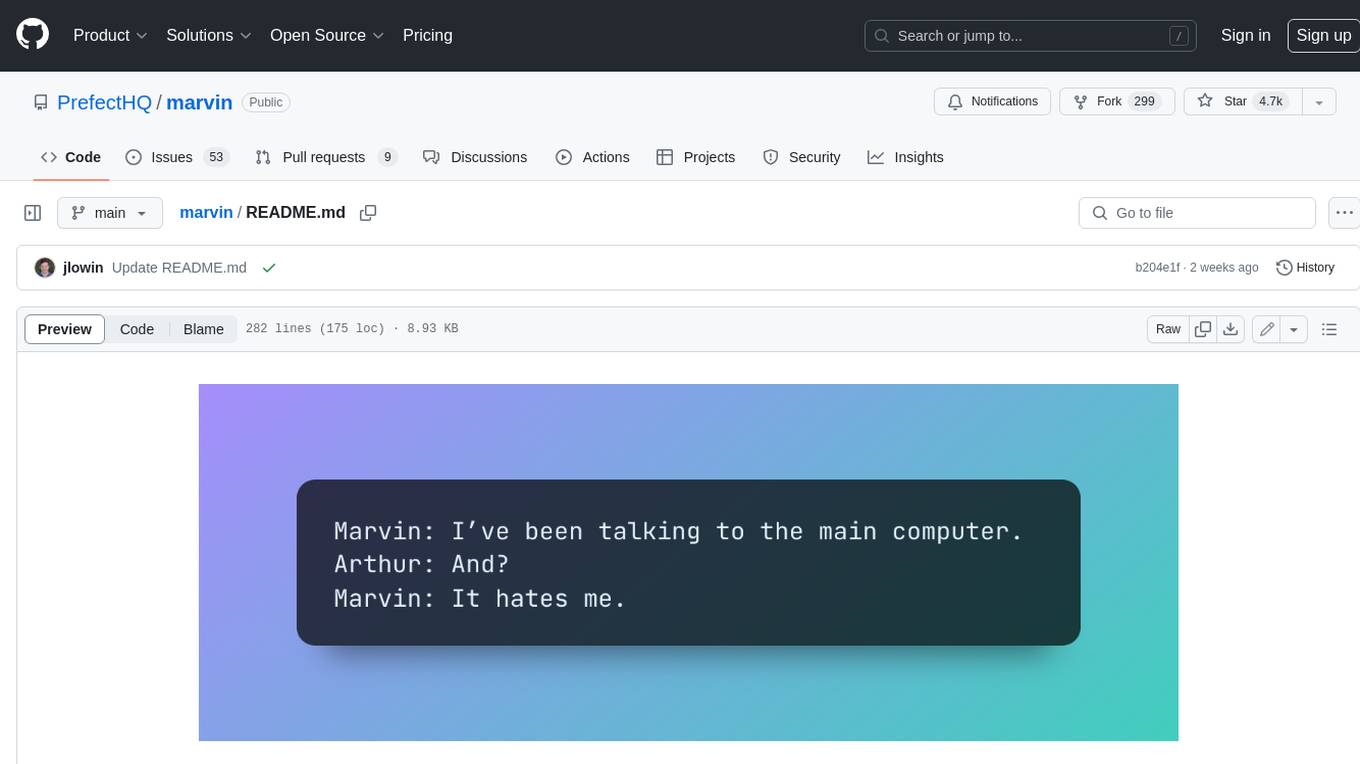
marvin
Marvin is a lightweight AI toolkit for building natural language interfaces that are reliable, scalable, and easy to trust. Each of Marvin's tools is simple and self-documenting, using AI to solve common but complex challenges like entity extraction, classification, and generating synthetic data. Each tool is independent and incrementally adoptable, so you can use them on their own or in combination with any other library. Marvin is also multi-modal, supporting both image and audio generation as well using images as inputs for extraction and classification. Marvin is for developers who care more about _using_ AI than _building_ AI, and we are focused on creating an exceptional developer experience. Marvin users should feel empowered to bring tightly-scoped "AI magic" into any traditional software project with just a few extra lines of code. Marvin aims to merge the best practices for building dependable, observable software with the best practices for building with generative AI into a single, easy-to-use library. It's a serious tool, but we hope you have fun with it. Marvin is open-source, free to use, and made with 💙 by the team at Prefect.

appworld
AppWorld is a high-fidelity execution environment of 9 day-to-day apps, operable via 457 APIs, populated with digital activities of ~100 people living in a simulated world. It provides a benchmark of natural, diverse, and challenging autonomous agent tasks requiring rich and interactive coding. The repository includes implementations of AppWorld apps and APIs, along with tests. It also introduces safety features for code execution and provides guides for building agents and extending the benchmark.
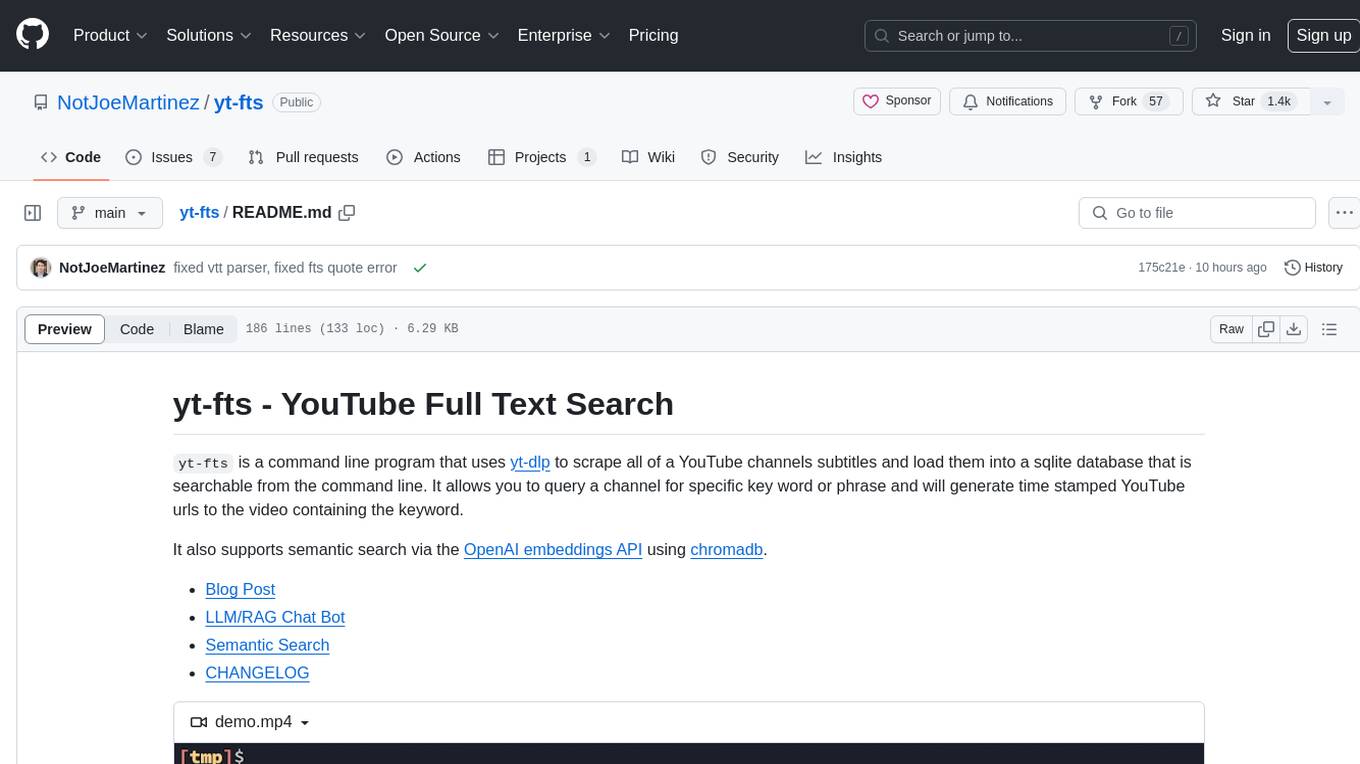
yt-fts
yt-fts is a command line program that uses yt-dlp to scrape all of a YouTube channels subtitles and load them into a sqlite database for full text search. It allows users to query a channel for specific keywords or phrases and generates time stamped YouTube URLs to the videos containing the keyword. Additionally, it supports semantic search via the OpenAI embeddings API using chromadb.
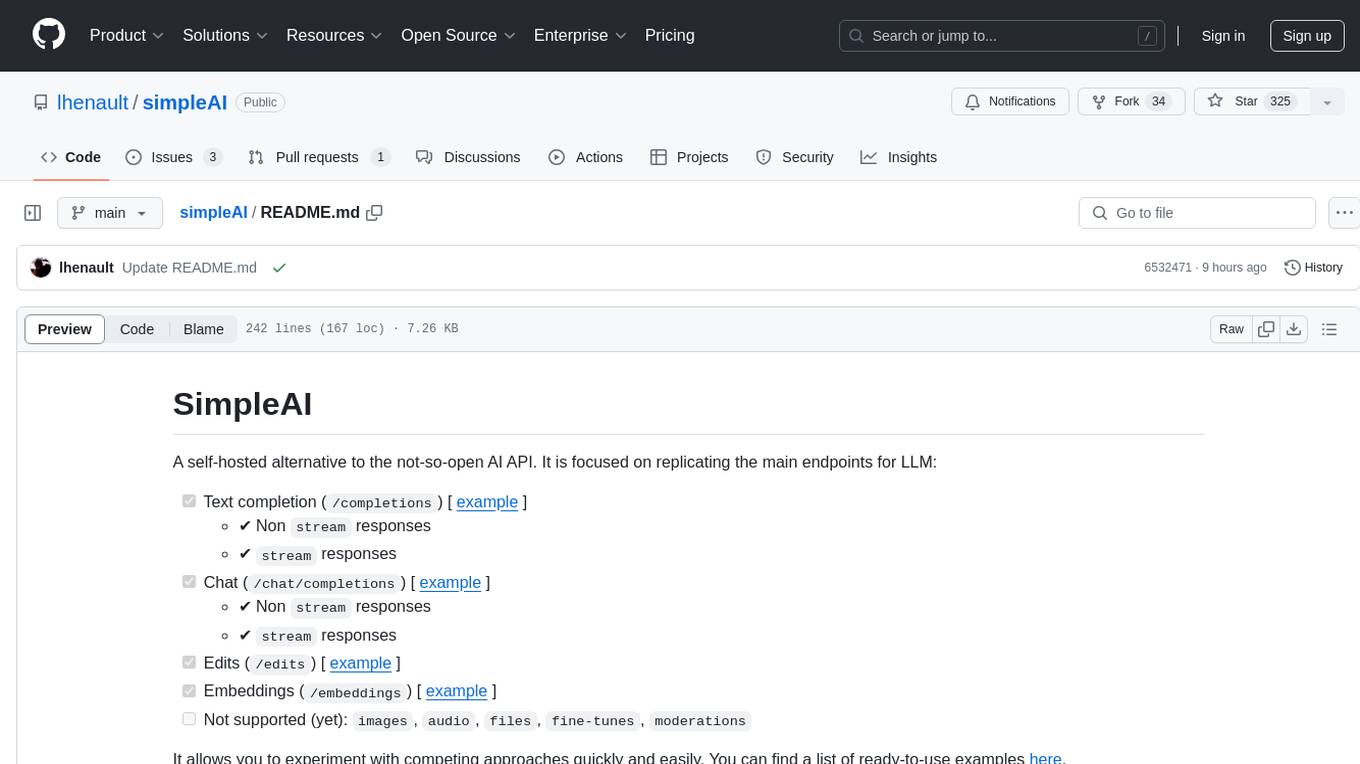
simpleAI
SimpleAI is a self-hosted alternative to the not-so-open AI API, focused on replicating main endpoints for LLM such as text completion, chat, edits, and embeddings. It allows quick experimentation with different models, creating benchmarks, and handling specific use cases without relying on external services. Users can integrate and declare models through gRPC, query endpoints using Swagger UI or API, and resolve common issues like CORS with FastAPI middleware. The project is open for contributions and welcomes PRs, issues, documentation, and more.
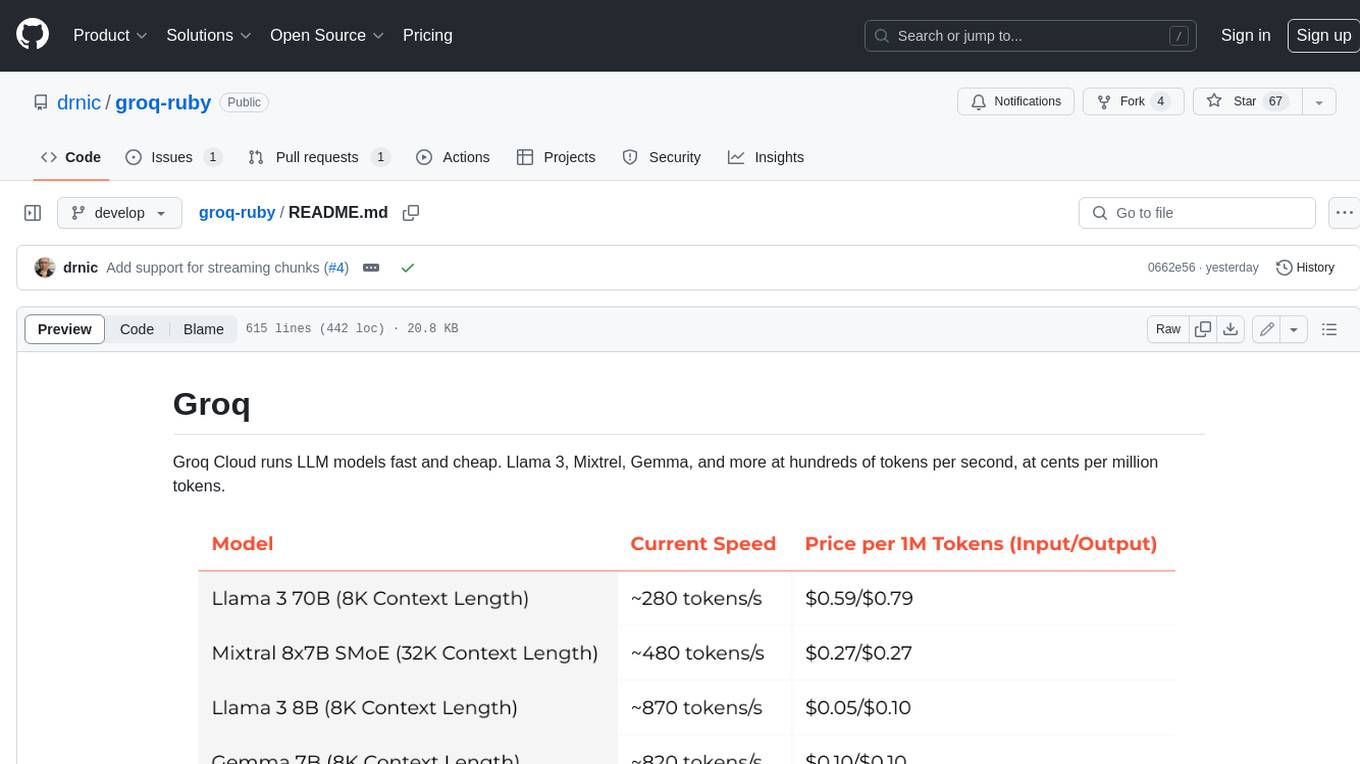
groq-ruby
Groq Cloud runs LLM models fast and cheap. Llama 3, Mixtrel, Gemma, and more at hundreds of tokens per second, at cents per million tokens.
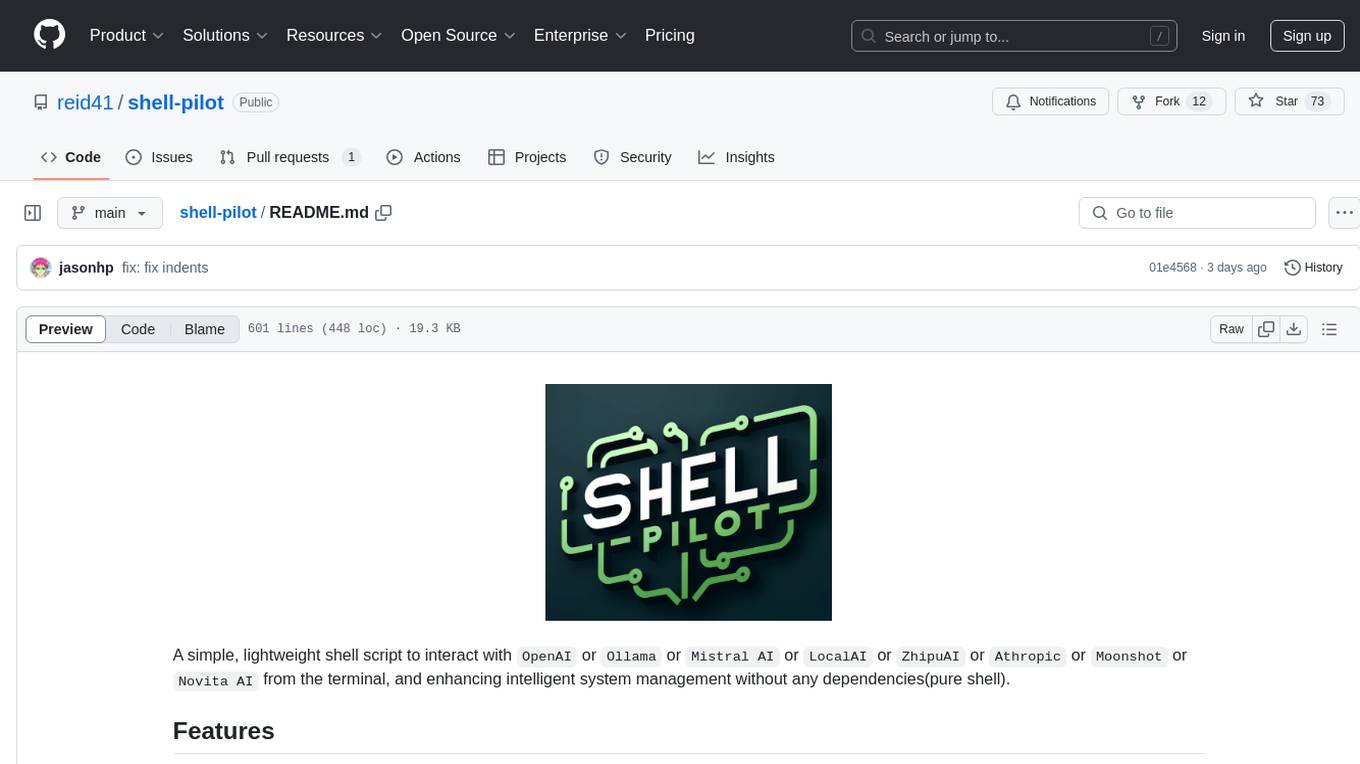
shell-pilot
Shell-pilot is a simple, lightweight shell script designed to interact with various AI models such as OpenAI, Ollama, Mistral AI, LocalAI, ZhipuAI, Anthropic, Moonshot, and Novita AI from the terminal. It enhances intelligent system management without any dependencies, offering features like setting up a local LLM repository, using official models and APIs, viewing history and session persistence, passing input prompts with pipe/redirector, listing available models, setting request parameters, generating and running commands in the terminal, easy configuration setup, system package version checking, and managing system aliases.
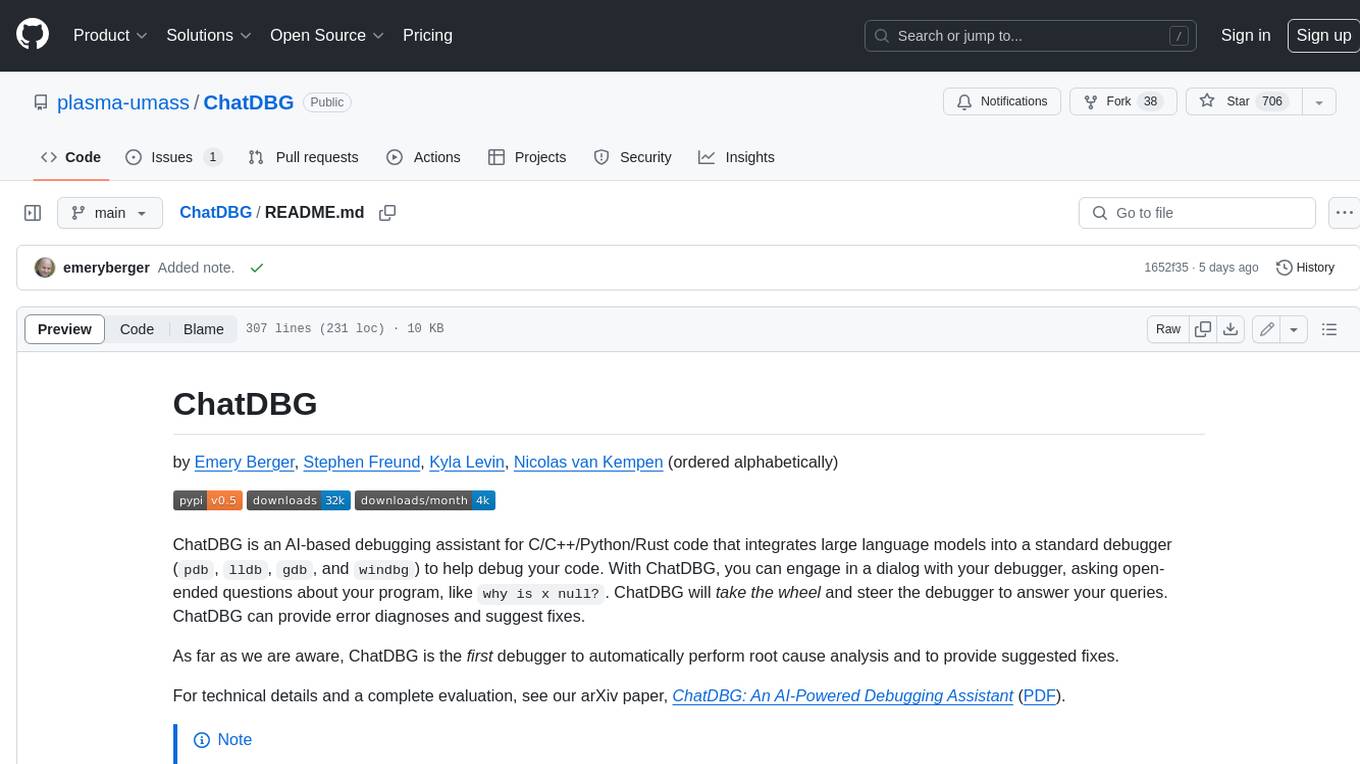
ChatDBG
ChatDBG is an AI-based debugging assistant for C/C++/Python/Rust code that integrates large language models into a standard debugger (`pdb`, `lldb`, `gdb`, and `windbg`) to help debug your code. With ChatDBG, you can engage in a dialog with your debugger, asking open-ended questions about your program, like `why is x null?`. ChatDBG will _take the wheel_ and steer the debugger to answer your queries. ChatDBG can provide error diagnoses and suggest fixes. As far as we are aware, ChatDBG is the _first_ debugger to automatically perform root cause analysis and to provide suggested fixes.
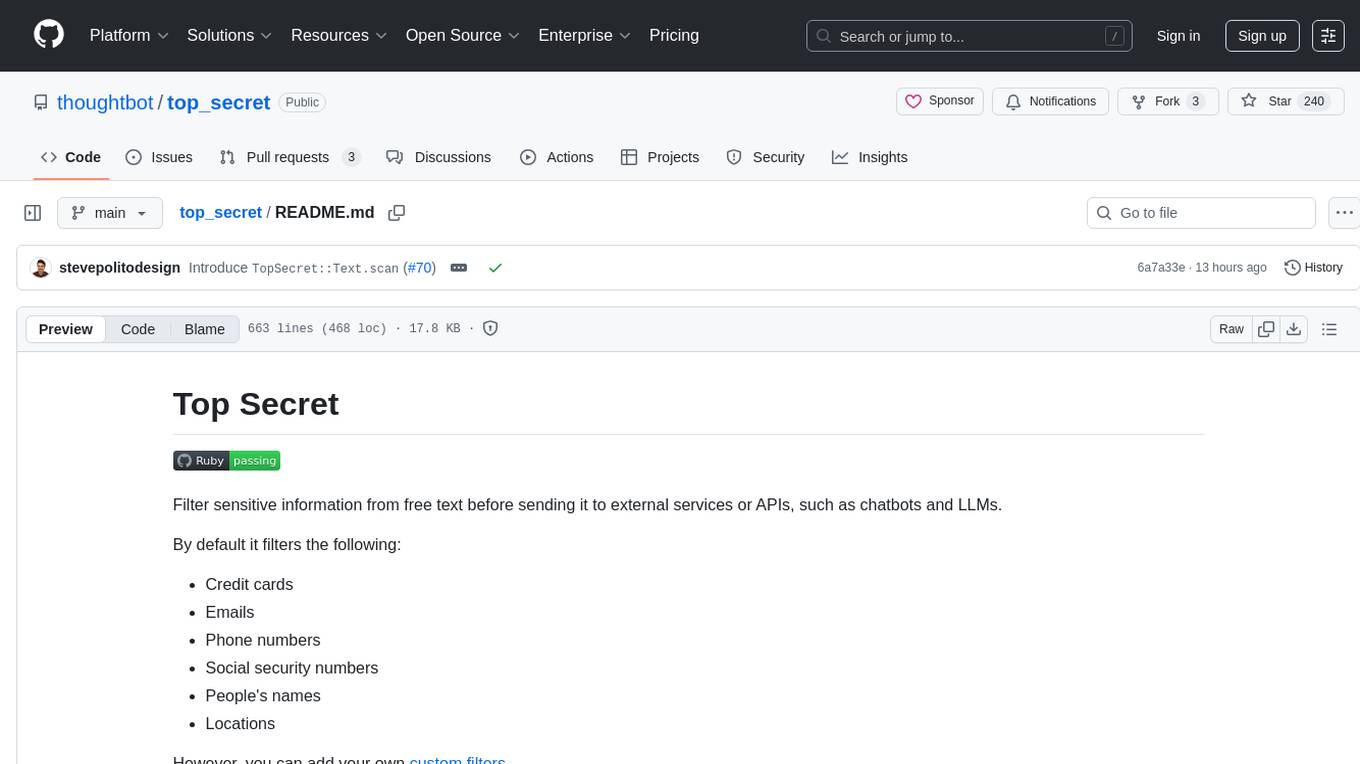
top_secret
Top Secret is a Ruby gem designed to filter sensitive information from free text before sending it to external services or APIs, such as chatbots and LLMs. It provides default filters for credit cards, emails, phone numbers, social security numbers, people's names, and locations, with the ability to add custom filters. Users can configure the tool to handle sensitive information redaction, scan for sensitive data, batch process messages, and restore filtered text from external services. Top Secret uses Regex and NER filters to detect and redact sensitive information, allowing users to override default filters, disable specific filters, and add custom filters globally. The tool is suitable for applications requiring data privacy and security measures.
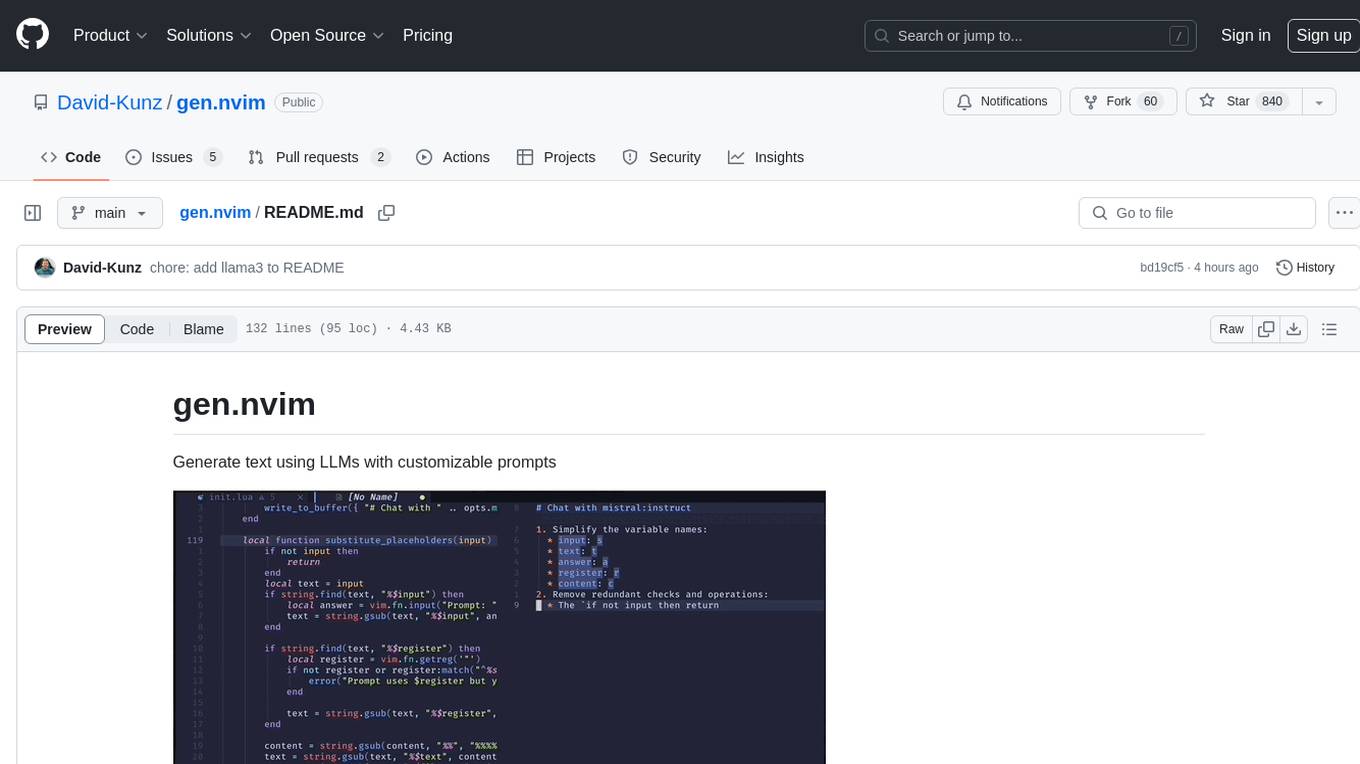
gen.nvim
gen.nvim is a tool that allows users to generate text using Language Models (LLMs) with customizable prompts. It requires Ollama with models like `llama3`, `mistral`, or `zephyr`, along with Curl for installation. Users can use the `Gen` command to generate text based on predefined or custom prompts. The tool provides key maps for easy invocation and allows for follow-up questions during conversations. Additionally, users can select a model from a list of installed models and customize prompts as needed.
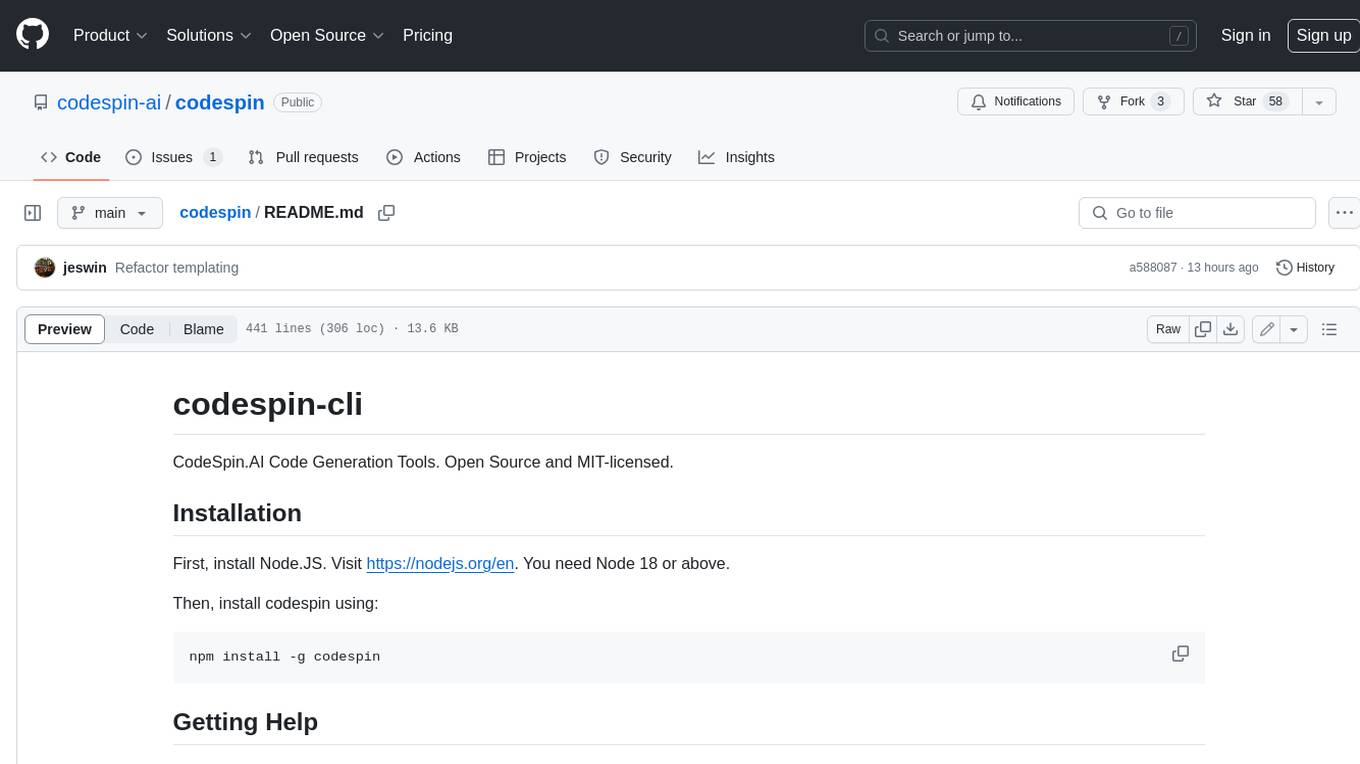
codespin
CodeSpin.AI is a set of open-source code generation tools that leverage large language models (LLMs) to automate coding tasks. With CodeSpin, you can generate code in various programming languages, including Python, JavaScript, Java, and C++, by providing natural language prompts. CodeSpin offers a range of features to enhance code generation, such as custom templates, inline prompting, and the ability to use ChatGPT as an alternative to API keys. Additionally, CodeSpin provides options for regenerating code, executing code in prompt files, and piping data into the LLM for processing. By utilizing CodeSpin, developers can save time and effort in coding tasks, improve code quality, and explore new possibilities in code generation.
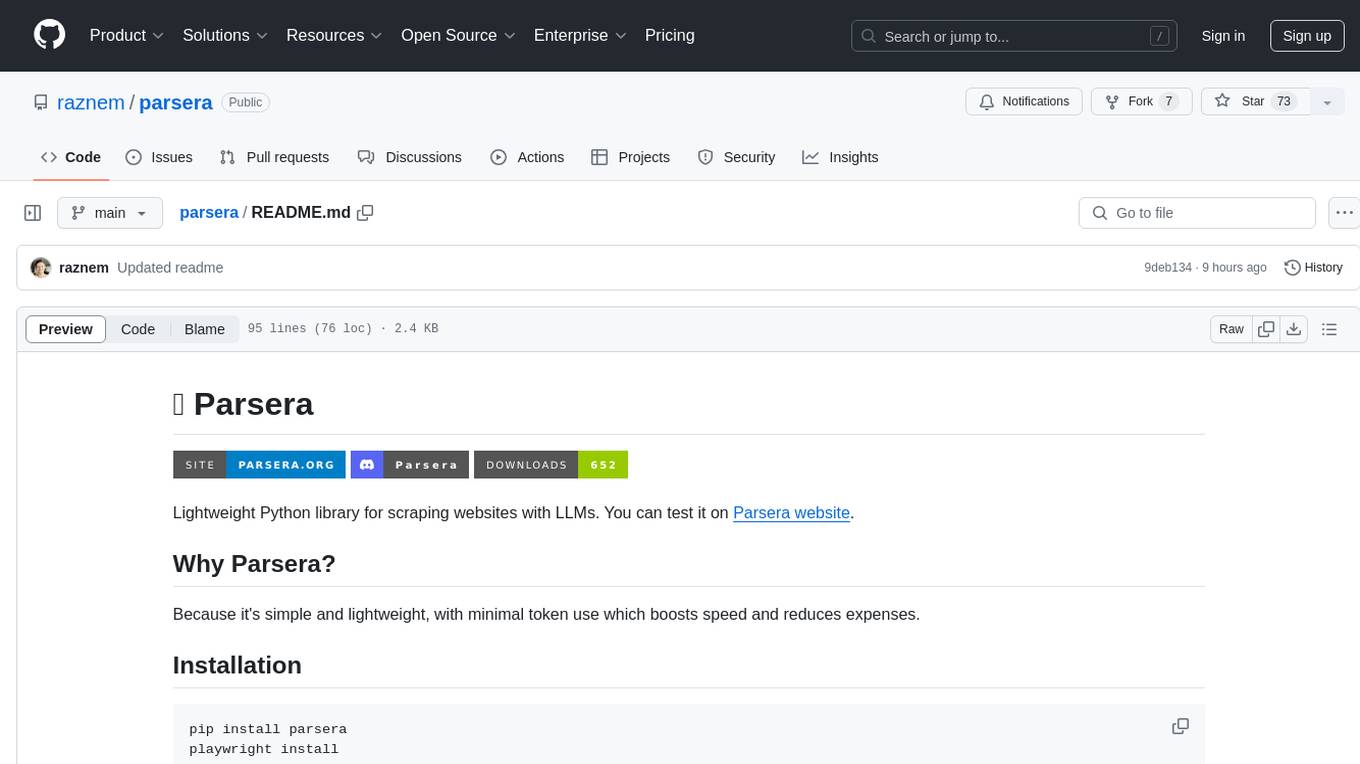
parsera
Parsera is a lightweight Python library designed for scraping websites using LLMs. It offers simplicity and efficiency by minimizing token usage, enhancing speed, and reducing costs. Users can easily set up and run the tool to extract specific elements from web pages, generating JSON output with relevant data. Additionally, Parsera supports integration with various chat models, such as Azure, expanding its functionality and customization options for web scraping tasks.
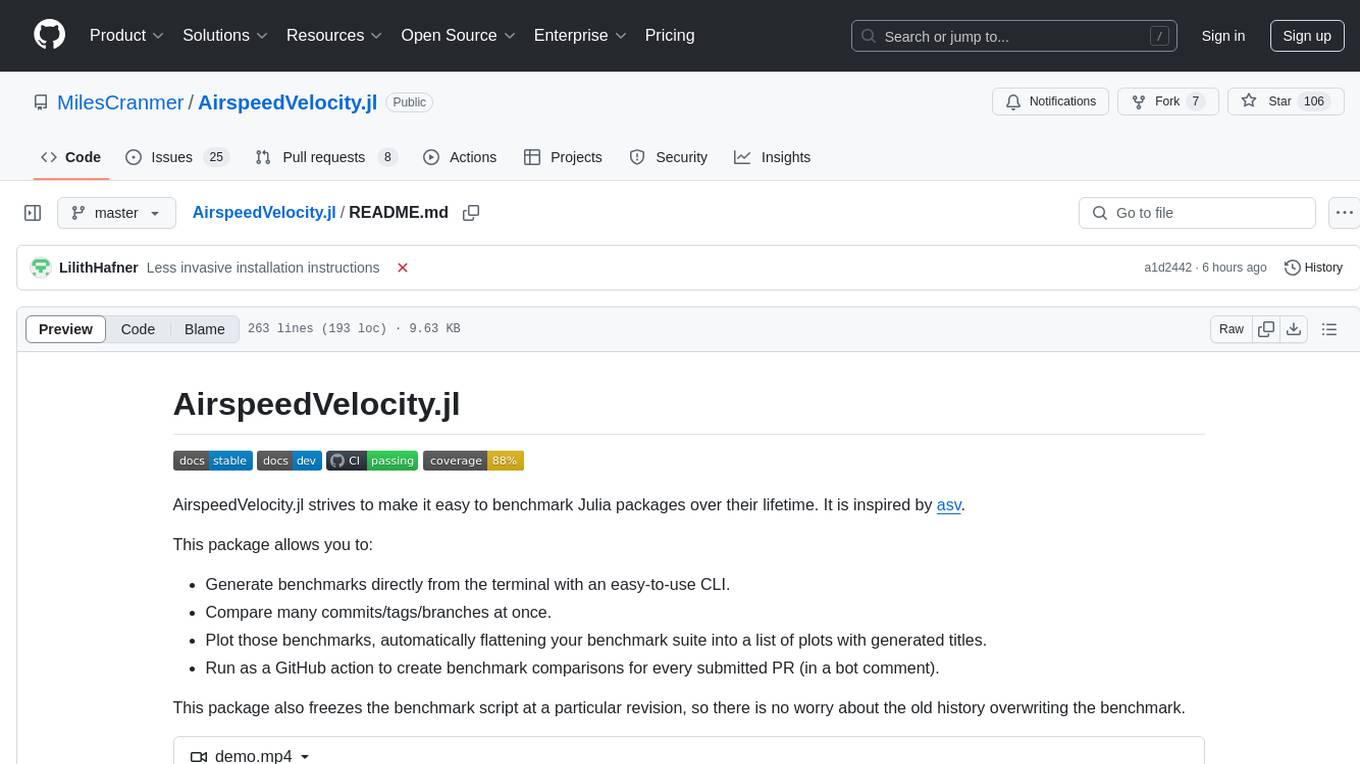
AirspeedVelocity.jl
AirspeedVelocity.jl is a tool designed to simplify benchmarking of Julia packages over their lifetime. It provides a CLI to generate benchmarks, compare commits/tags/branches, plot benchmarks, and run benchmark comparisons for every submitted PR as a GitHub action. The tool freezes the benchmark script at a specific revision to prevent old history from affecting benchmarks. Users can configure options using CLI flags and visualize benchmark results. AirspeedVelocity.jl can be used to benchmark any Julia package and offers features like generating tables and plots of benchmark results. It also supports custom benchmarks and can be integrated into GitHub actions for automated benchmarking of PRs.
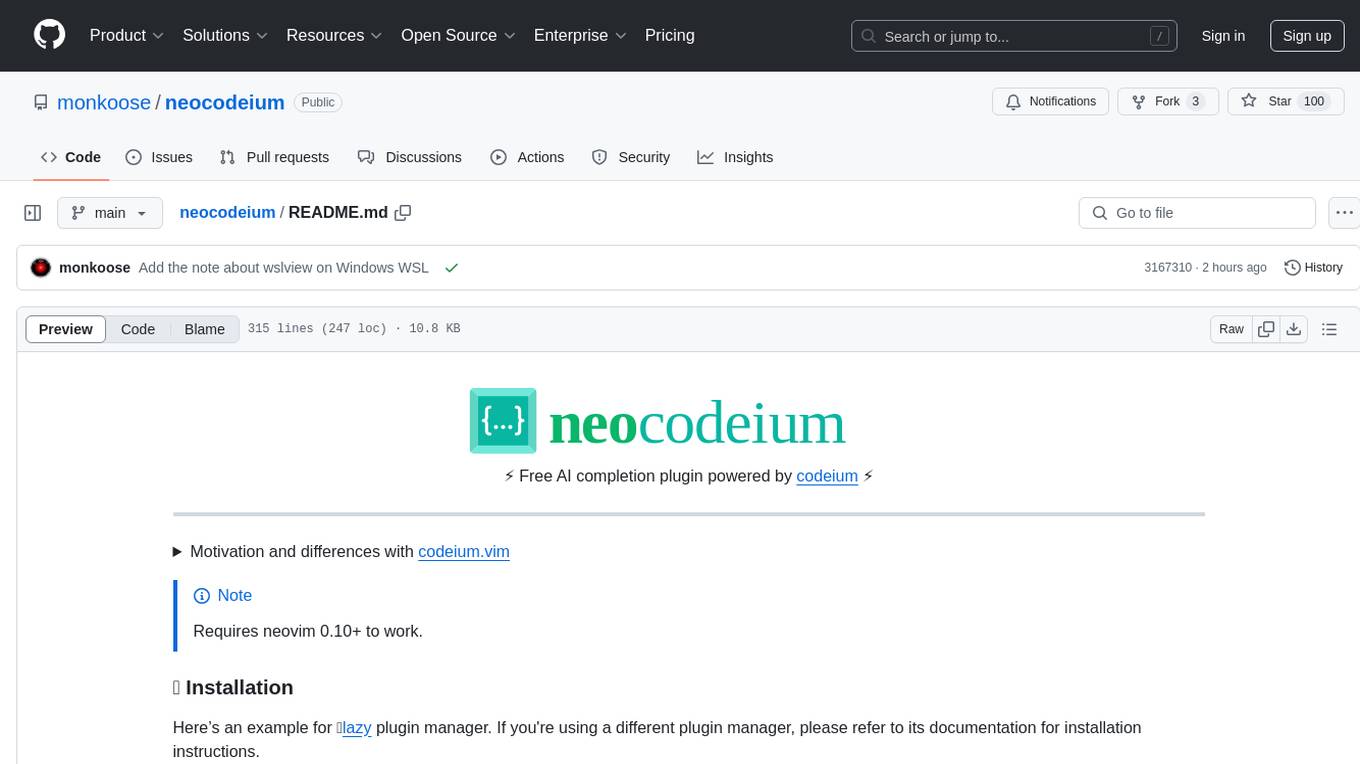
neocodeium
NeoCodeium is a free AI completion plugin powered by Codeium, designed for Neovim users. It aims to provide a smoother experience by eliminating flickering suggestions and allowing for repeatable completions using the `.` key. The plugin offers performance improvements through cache techniques, displays suggestion count labels, and supports Lua scripting. Users can customize keymaps, manage suggestions, and interact with the AI chat feature. NeoCodeium enhances code completion in Neovim, making it a valuable tool for developers seeking efficient coding assistance.
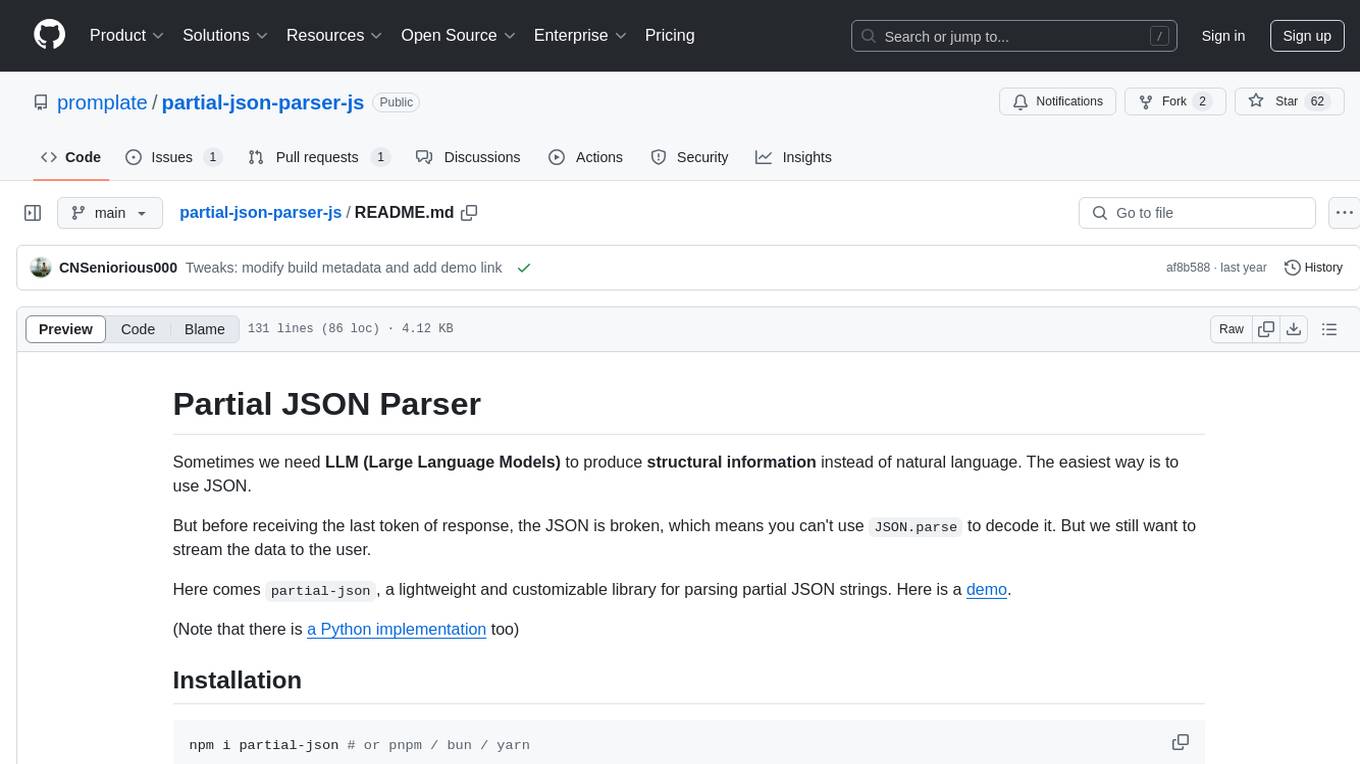
partial-json-parser-js
Partial JSON Parser is a lightweight and customizable library for parsing partial JSON strings. It allows users to parse incomplete JSON data and stream it to the user. The library provides options to specify what types of partialness are allowed during parsing, such as strings, objects, arrays, special values, and more. It helps handle malformed JSON and returns the parsed JavaScript value. Partial JSON Parser is implemented purely in JavaScript and offers both commonjs and esm builds.

aider.nvim
Aider.nvim is a Neovim plugin that integrates the Aider AI coding assistant, allowing users to open a terminal window within Neovim to run Aider. It provides functions like AiderOpen to open the terminal window, AiderAddModifiedFiles to add git-modified files to the Aider chat, and customizable keybindings. Users can configure the plugin using the setup function to manage context, keybindings, debug logging, and ignore specific buffer names.
For similar tasks

shell_gpt
ShellGPT is a command-line productivity tool powered by AI large language models (LLMs). This command-line tool offers streamlined generation of shell commands, code snippets, documentation, eliminating the need for external resources (like Google search). Supports Linux, macOS, Windows and compatible with all major Shells like PowerShell, CMD, Bash, Zsh, etc.
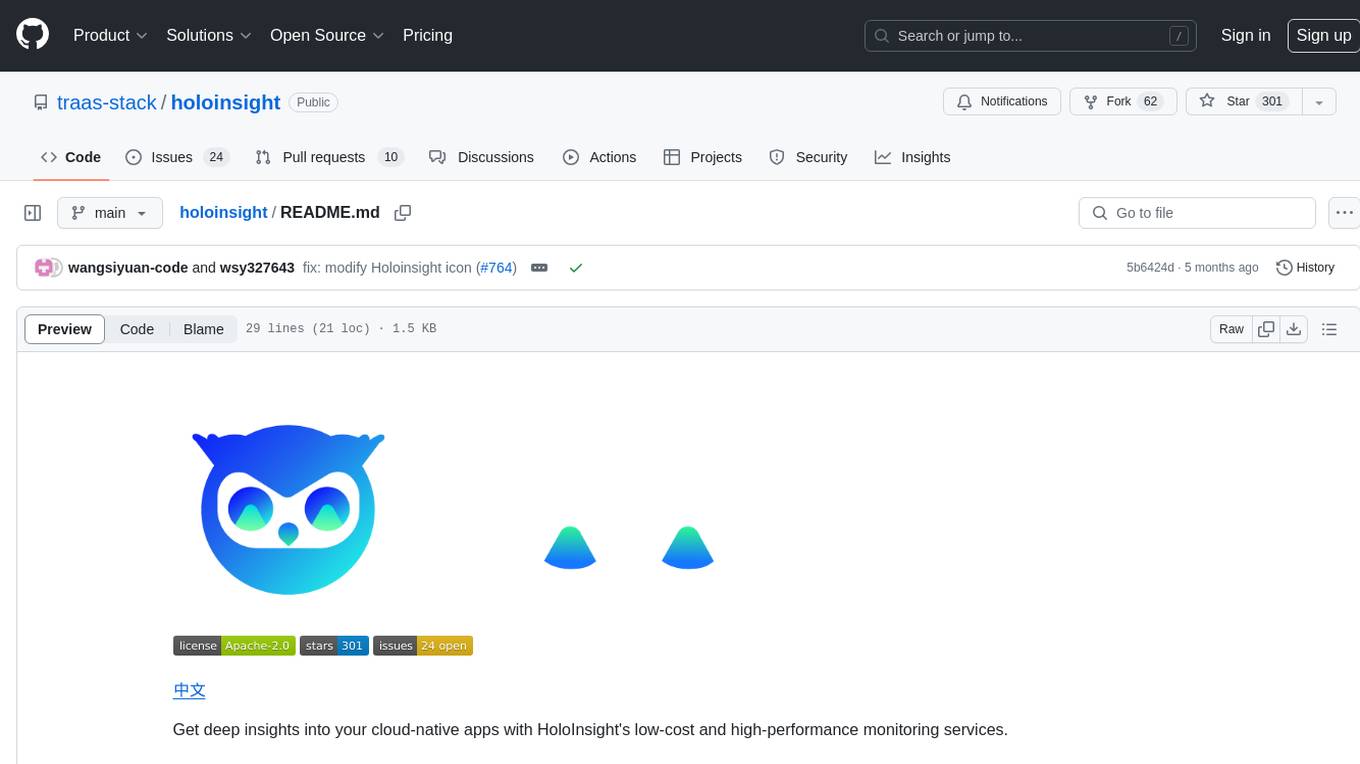
holoinsight
HoloInsight is a cloud-native observability platform that provides low-cost and high-performance monitoring services for cloud-native applications. It offers deep insights through real-time log analysis and AI integration. The platform is designed to help users gain a comprehensive understanding of their applications' performance and behavior in the cloud environment. HoloInsight is easy to deploy using Docker and Kubernetes, making it a versatile tool for monitoring and optimizing cloud-native applications. With a focus on scalability and efficiency, HoloInsight is suitable for organizations looking to enhance their observability and monitoring capabilities in the cloud.
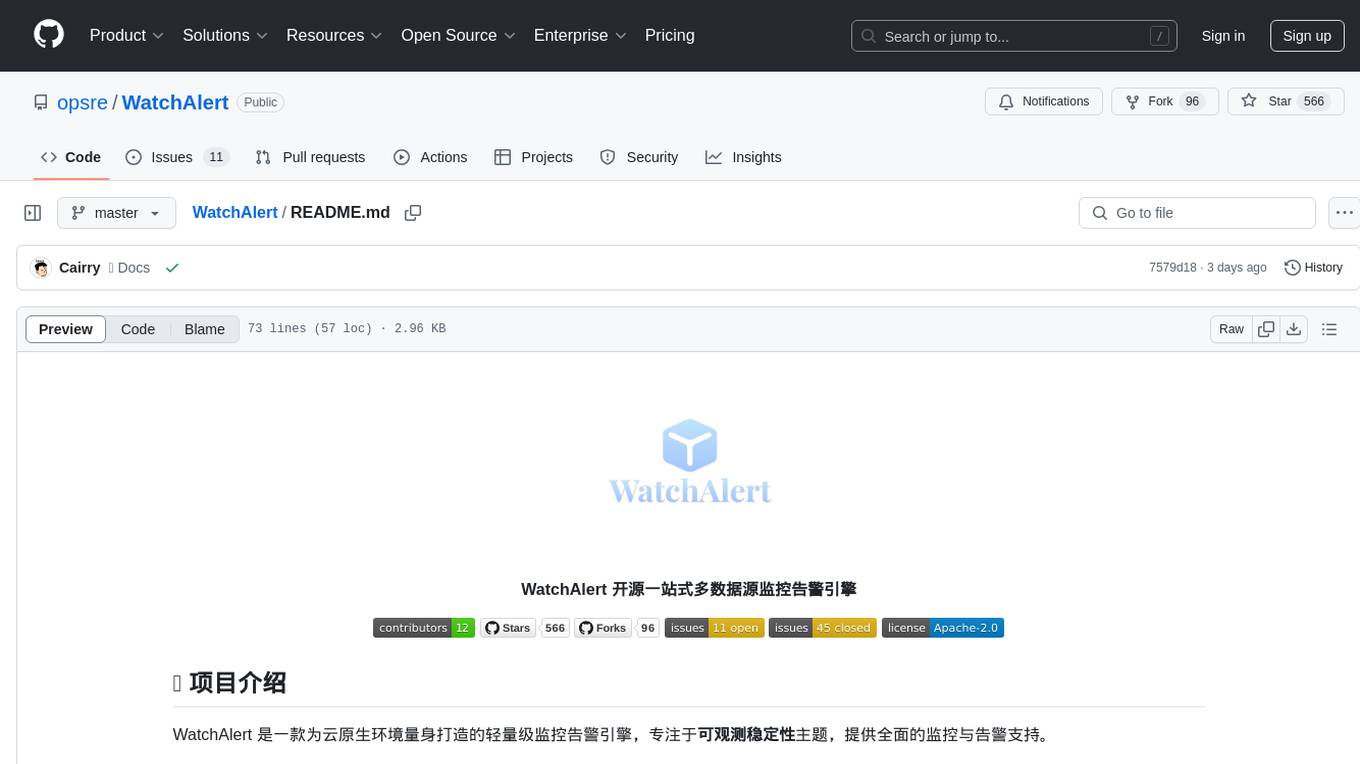
WatchAlert
WatchAlert is a lightweight monitoring and alerting engine tailored for cloud-native environments, focusing on observability and stability themes. It provides comprehensive monitoring and alerting support, including AI-powered alert analysis for efficient troubleshooting. WatchAlert integrates with various data sources such as Prometheus, VictoriaMetrics, Loki, Elasticsearch, AliCloud SLS, Jaeger, Kubernetes, and different network protocols for monitoring and supports alert notifications via multiple channels like Feishu, DingTalk, WeChat Work, email, and custom hooks. It is optimized for cloud-native environments, easy to use, offers flexible alert rule configurations, and specializes in stability scenarios to help users quickly identify and resolve issues, providing a reliable monitoring and alerting solution to enhance operational efficiency and reduce maintenance costs.
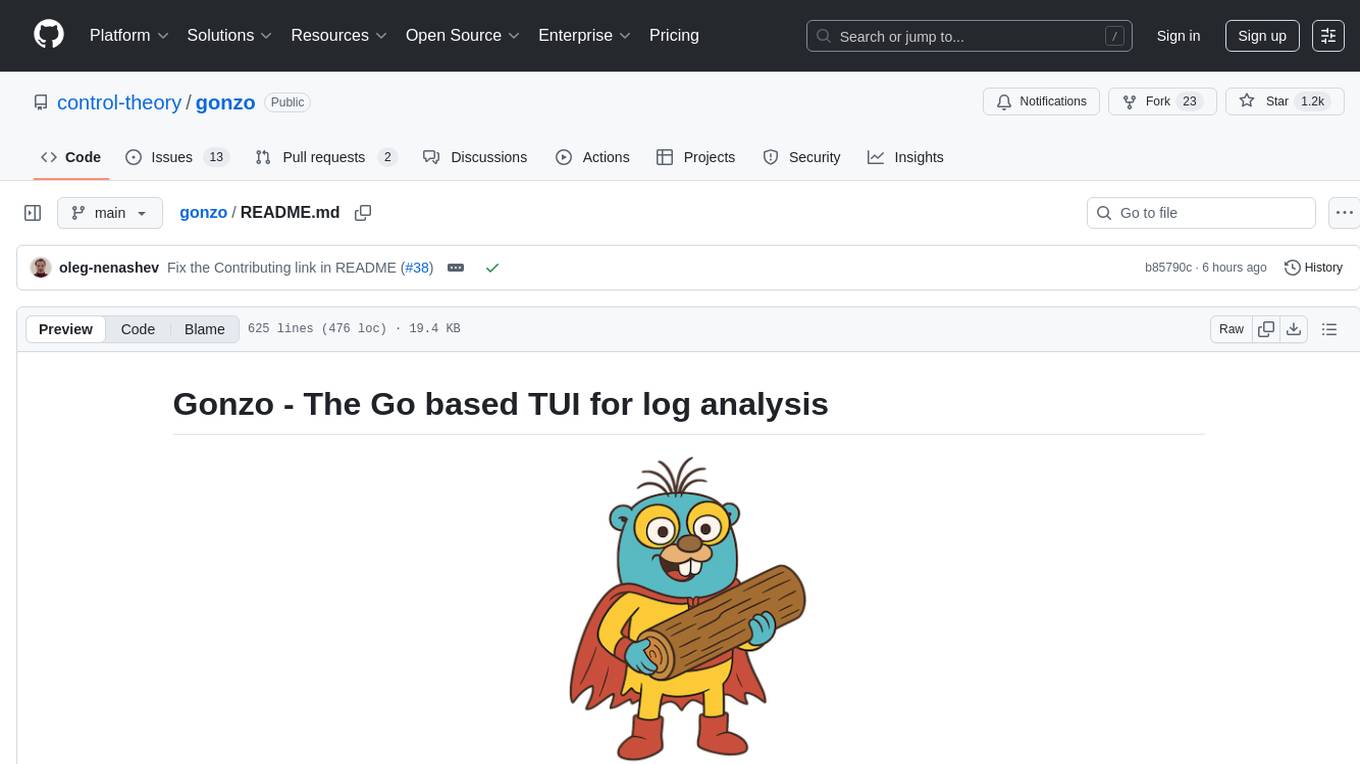
gonzo
Gonzo is a powerful, real-time log analysis terminal UI tool inspired by k9s. It allows users to analyze log streams with beautiful charts, AI-powered insights, and advanced filtering directly from the terminal. The tool provides features like live streaming log processing, OTLP support, interactive dashboard with real-time charts, advanced filtering options including regex support, and AI-powered insights such as pattern detection, anomaly analysis, and root cause suggestions. Users can also configure AI models from providers like OpenAI, LM Studio, and Ollama for intelligent log analysis. Gonzo is built with Bubble Tea, Lipgloss, Cobra, Viper, and OpenTelemetry, following a clean architecture with separate modules for TUI, log analysis, frequency tracking, OTLP handling, and AI integration.
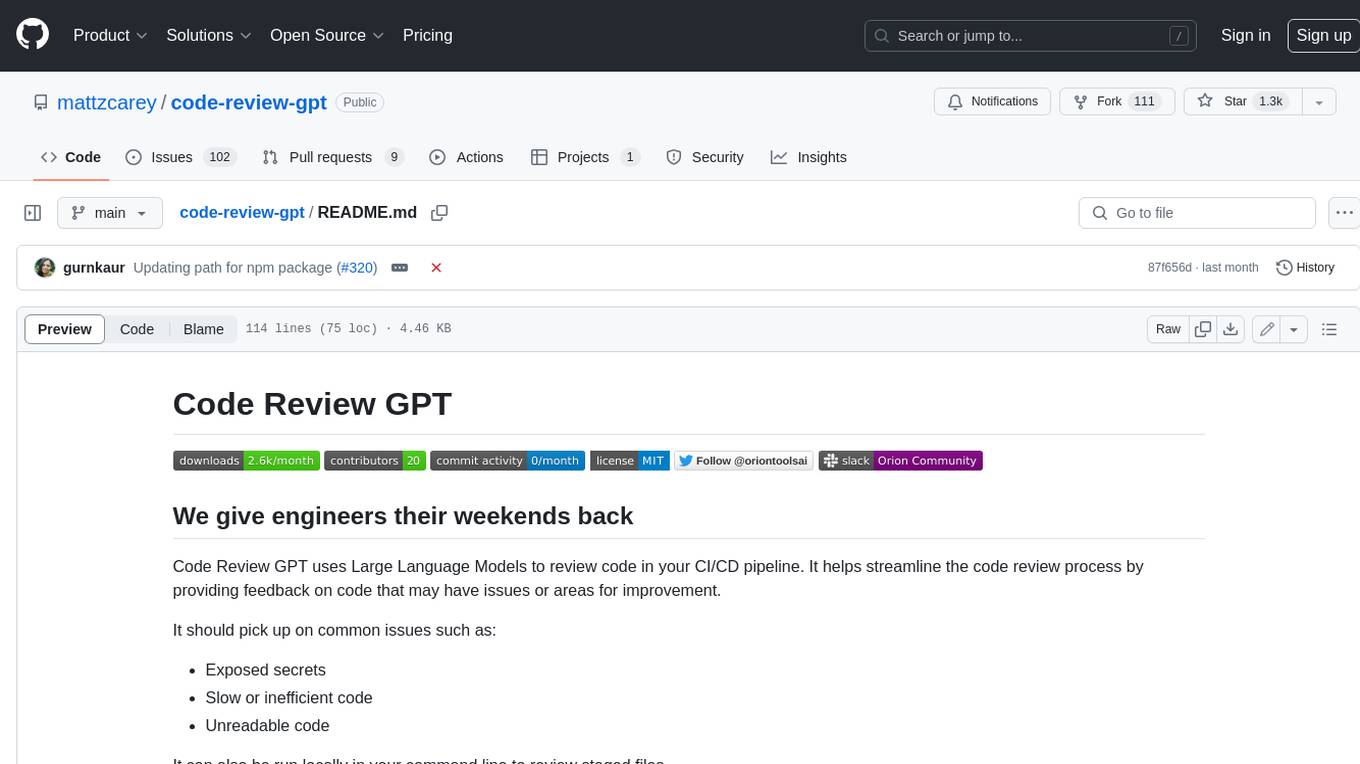
code-review-gpt
Code Review GPT uses Large Language Models to review code in your CI/CD pipeline. It helps streamline the code review process by providing feedback on code that may have issues or areas for improvement. It should pick up on common issues such as exposed secrets, slow or inefficient code, and unreadable code. It can also be run locally in your command line to review staged files. Code Review GPT is in alpha and should be used for fun only. It may provide useful feedback but please check any suggestions thoroughly.
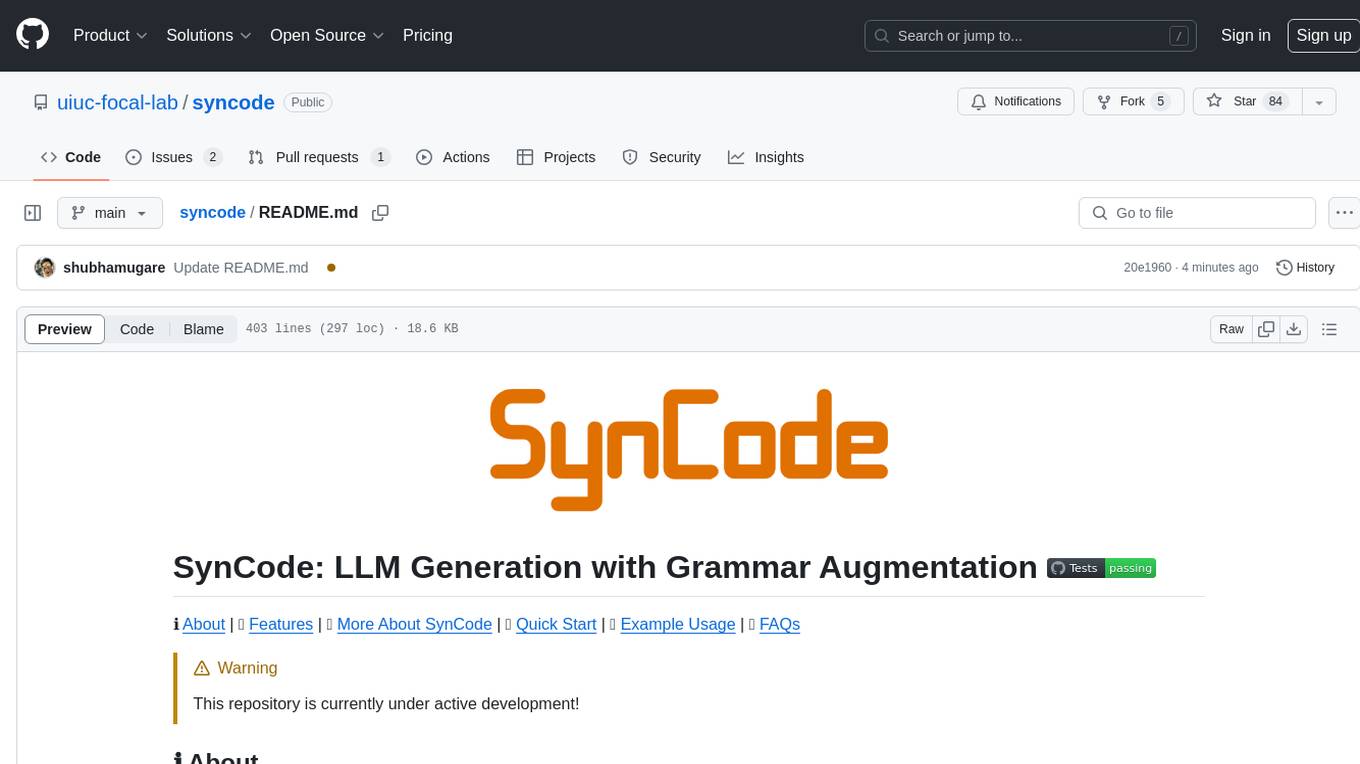
syncode
SynCode is a novel framework for the grammar-guided generation of Large Language Models (LLMs) that ensures syntactically valid output with respect to defined Context-Free Grammar (CFG) rules. It supports general-purpose programming languages like Python, Go, SQL, JSON, and more, allowing users to define custom grammars using EBNF syntax. The tool compares favorably to other constrained decoders and offers features like fast grammar-guided generation, compatibility with HuggingFace Language Models, and the ability to work with various decoding strategies.
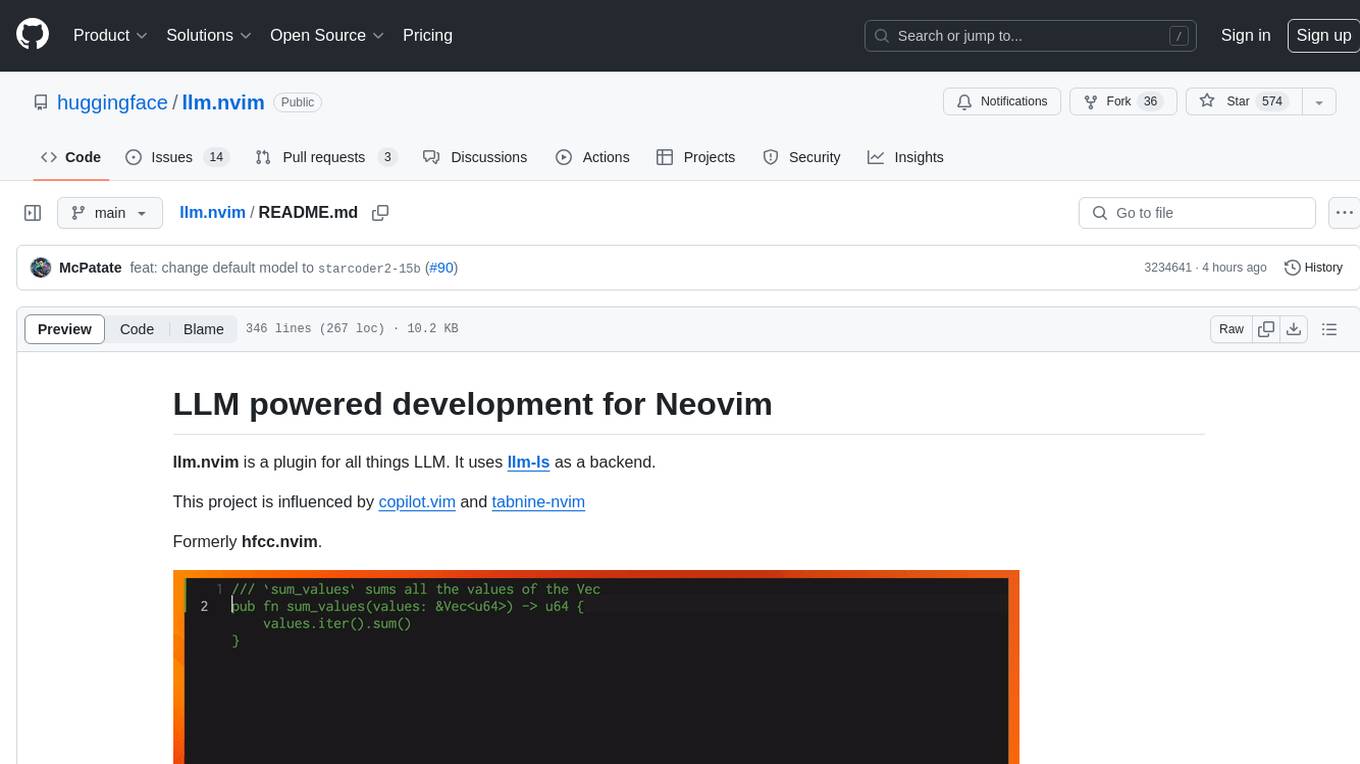
llm.nvim
llm.nvim is a plugin for Neovim that enables code completion using LLM models. It supports 'ghost-text' code completion similar to Copilot and allows users to choose their model for code generation via HTTP requests. The plugin interfaces with multiple backends like Hugging Face, Ollama, Open AI, and TGI, providing flexibility in model selection and configuration. Users can customize the behavior of suggestions, tokenization, and model parameters to enhance their coding experience. llm.nvim also includes commands for toggling auto-suggestions and manually requesting suggestions, making it a versatile tool for developers using Neovim.
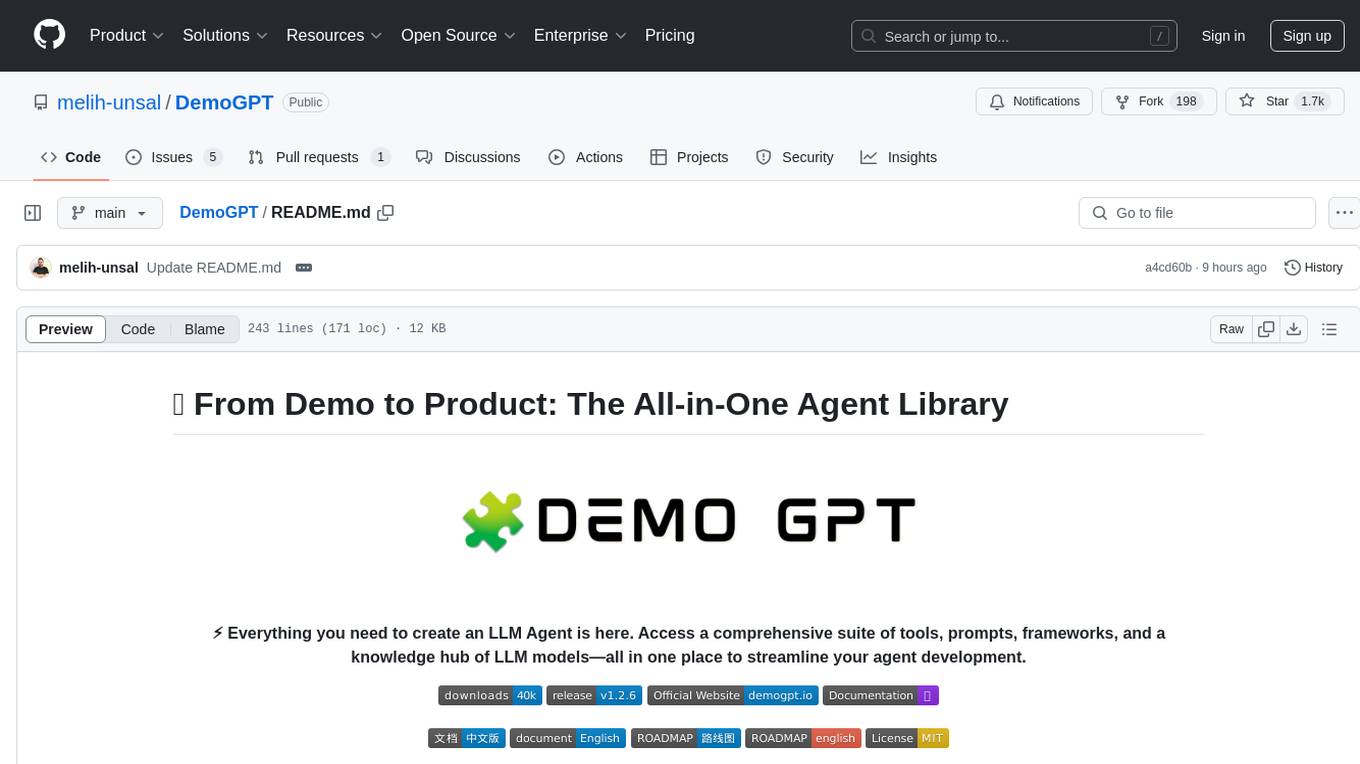
DemoGPT
DemoGPT is an all-in-one agent library that provides tools, prompts, frameworks, and LLM models for streamlined agent development. It leverages GPT-3.5-turbo to generate LangChain code, creating interactive Streamlit applications. The tool is designed for creating intelligent, interactive, and inclusive solutions in LLM-based application development. It offers model flexibility, iterative development, and a commitment to user engagement. Future enhancements include integrating Gorilla for autonomous API usage and adding a publicly available database for refining the generation process.
For similar jobs

weave
Weave is a toolkit for developing Generative AI applications, built by Weights & Biases. With Weave, you can log and debug language model inputs, outputs, and traces; build rigorous, apples-to-apples evaluations for language model use cases; and organize all the information generated across the LLM workflow, from experimentation to evaluations to production. Weave aims to bring rigor, best-practices, and composability to the inherently experimental process of developing Generative AI software, without introducing cognitive overhead.

agentcloud
AgentCloud is an open-source platform that enables companies to build and deploy private LLM chat apps, empowering teams to securely interact with their data. It comprises three main components: Agent Backend, Webapp, and Vector Proxy. To run this project locally, clone the repository, install Docker, and start the services. The project is licensed under the GNU Affero General Public License, version 3 only. Contributions and feedback are welcome from the community.

oss-fuzz-gen
This framework generates fuzz targets for real-world `C`/`C++` projects with various Large Language Models (LLM) and benchmarks them via the `OSS-Fuzz` platform. It manages to successfully leverage LLMs to generate valid fuzz targets (which generate non-zero coverage increase) for 160 C/C++ projects. The maximum line coverage increase is 29% from the existing human-written targets.

LLMStack
LLMStack is a no-code platform for building generative AI agents, workflows, and chatbots. It allows users to connect their own data, internal tools, and GPT-powered models without any coding experience. LLMStack can be deployed to the cloud or on-premise and can be accessed via HTTP API or triggered from Slack or Discord.

VisionCraft
The VisionCraft API is a free API for using over 100 different AI models. From images to sound.

kaito
Kaito is an operator that automates the AI/ML inference model deployment in a Kubernetes cluster. It manages large model files using container images, avoids tuning deployment parameters to fit GPU hardware by providing preset configurations, auto-provisions GPU nodes based on model requirements, and hosts large model images in the public Microsoft Container Registry (MCR) if the license allows. Using Kaito, the workflow of onboarding large AI inference models in Kubernetes is largely simplified.

PyRIT
PyRIT is an open access automation framework designed to empower security professionals and ML engineers to red team foundation models and their applications. It automates AI Red Teaming tasks to allow operators to focus on more complicated and time-consuming tasks and can also identify security harms such as misuse (e.g., malware generation, jailbreaking), and privacy harms (e.g., identity theft). The goal is to allow researchers to have a baseline of how well their model and entire inference pipeline is doing against different harm categories and to be able to compare that baseline to future iterations of their model. This allows them to have empirical data on how well their model is doing today, and detect any degradation of performance based on future improvements.

Azure-Analytics-and-AI-Engagement
The Azure-Analytics-and-AI-Engagement repository provides packaged Industry Scenario DREAM Demos with ARM templates (Containing a demo web application, Power BI reports, Synapse resources, AML Notebooks etc.) that can be deployed in a customer’s subscription using the CAPE tool within a matter of few hours. Partners can also deploy DREAM Demos in their own subscriptions using DPoC.
